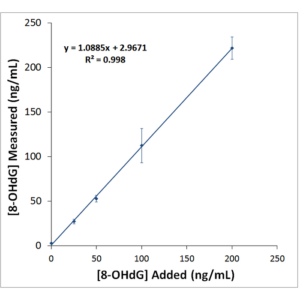8-OH-dG, a Novel Immune Activator
Innate immunity against viral or pathogenic infection involves sensing of non-self-molecules, otherwise known at pathogen-associated molecular patterns (PAMPs). This same sensing mechanism can be applied to damaged self-molecules, which are called damage-associated molecular patterns (DAMPs). One type of molecular pattern, for both groups, is cytosolic or extracellular DNA. However, there is not an extensive amount of research showing specifically what type of DAMP DNA molecule is best at activating this immune sensing response. A recent study investigated the mechanism behind how oxidized DNA from UV damage activates an immune sensing response.
A group of researchers from Institute of Clinical Chemistry and Clinical Pharmacology, University of Bonn found that, compared to a variety of types of cellular damage, damage from UV irradiation created a strong immune response (type I IFN response), seen across different types of immune regulatory cells. This was compared with freeze/thaw, physical damage and nutritional deprivation, each of which did not produce a noticeable immune response. Additionally, this immune response was seen when DNA was exposed to UV-A and UV-B (the type of radiation produced by our sun) and UV-C radiation.
DNA can be damaged by UV light directly, or through reactive oxygen species (ROS) caused by UV light. A well-known mark of DNA damaged by ROS is the oxidation of guanine to create 8-hydroxyguanine (8-OH-dG). These researchers saw an increase in 8-OH-dG dependant on the level of UV dose, and this also correlated with an increase in immune response; showing that DNA damage created by UV light in the form of 8-OH-dG is sufficient to activate an immune response. This study shows that 8-OH-dG can be classified at a DAMP.
Next, this group wanted to place a mechanism to these observations. They found that the ability of oxidation-damaged DNA to activate an immune response was dependant on cGAS and STING. Free DNA in the cytosol binds cGAS, a cGAMP synthase. This action produces a messenger molecule which proceeds to bind to and activate STING, an endoplasmic reticulum protein. STING activation will ultimately stimulate a type I IFN response.
When a cell’s own DNA is damaged, the cell’s machinery does all it can to repair it. This sometimes involves erasing, or degrading, the DNA that has been damaged. The enzyme, TREX1 exonuclease, has this job in a cell. However, this group found that when DNA was modified with an 8-OH-dG, it was resistant to this degradation by TREX1. This implies that the observed increase in immune response due to the presence of 8-OH-dG occurred because of an accumulation of damaged DNA, because it was not being degraded by TREX1 and could therefore sufficiently activate cGAS and STING.
This type of study has important implications for autoimmune diseases like lupus erythematosus (LE), which is characterized by its abnormally high number of autoantibodies against DNA. It is possible that this uncontrollable immune response is activated by oxidation-damaged DNA. Studies in this area, therefore, hold great importance.
The original research paper was published in:
8-OH-dG levels for this experiment were determined using StressMarq’s highly cited DNA Damage (8-OHdG) ELISA Kit. StressMarq also sells an antibody that detects DNA/RNA Damage (catalog# SMC-155).

Urine Spike Assay from StressMarq’s DNA Damage (8-OHdG) ELISA Kit.

Leave a Reply